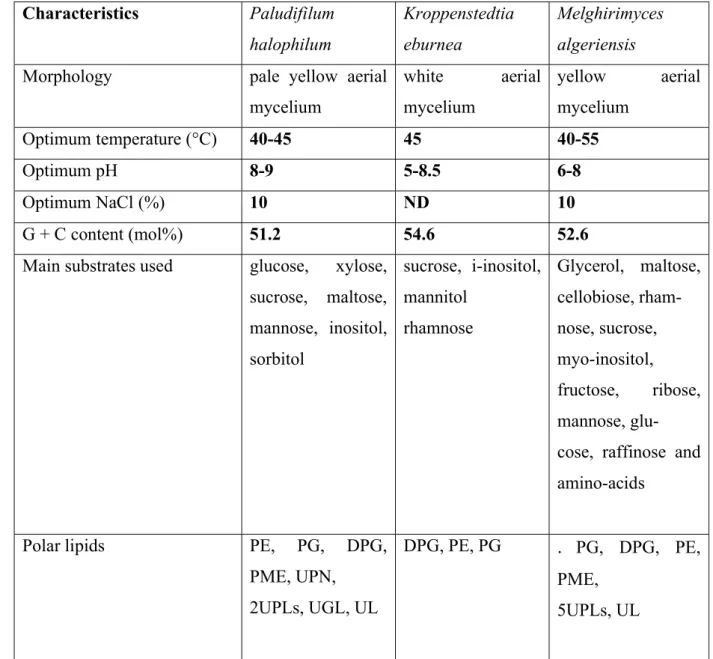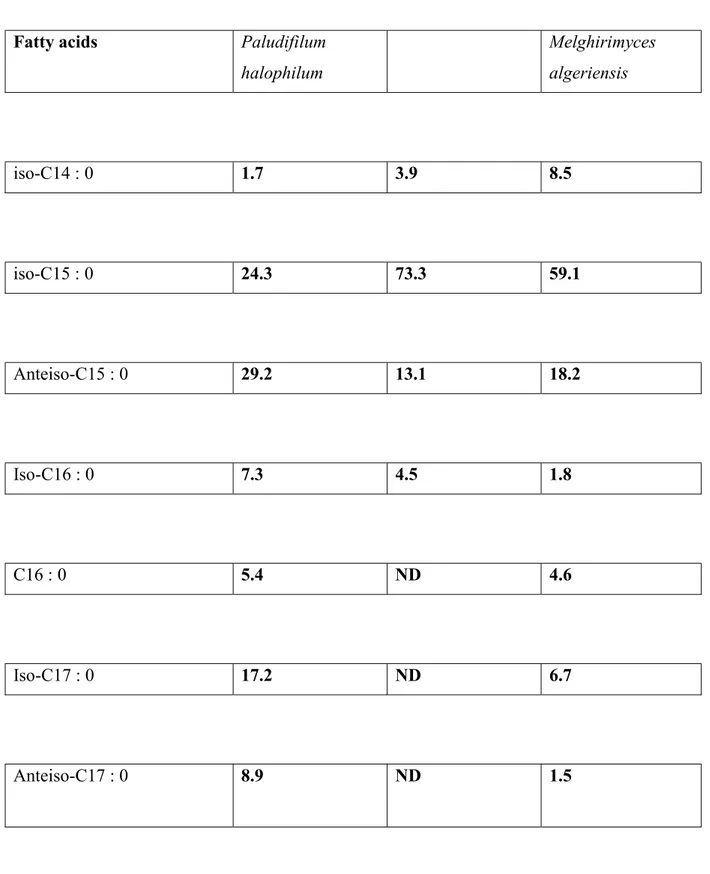HAL Id: hal-02883924
https://hal.archives-ouvertes.fr/hal-02883924
Submitted on 29 Jun 2020HAL is a multi-disciplinary open access
archive for the deposit and dissemination of sci-entific research documents, whether they are pub-lished or not. The documents may come from teaching and research institutions in France or abroad, or from public or private research centers.
L’archive ouverte pluridisciplinaire HAL, est destinée au dépôt et à la diffusion de documents scientifiques de niveau recherche, publiés ou non, émanant des établissements d’enseignement et de recherche français ou étrangers, des laboratoires publics ou privés.
Genus Paludifilum
Marie-Laure Fardeau, Jean-Luc Cayol, Bernard Ollivier
To cite this version:
Marie-Laure Fardeau, Jean-Luc Cayol, Bernard Ollivier. Genus Paludifilum. Bergey’s Manual of Systematics of Archaea and Bacteria (BMSAB), Hoboken, New Jersey : Wiley, [2015]-, 2019. �hal-02883924�
Genus Paludifilum 1
2
Defining publication: Frikha-Dammak, Fardeau, Cayol, Ben Fguira-Fourati, Najeh, 3
Ollivier and Maale 2016, 5371 VP
4 5
Authors: Marie-Laure Fardeau, Jean-Luc Cayol, Bernard Ollivier 6
7
Aix Marseille Université, IRD, Université de Toulon, CNRS, Mediterranean Institute of 8
Oceanography (MIO), UM 110, 13288 Marseille cedex 9, France 9 10 11 12 Etymology: 13
Pa.lu.di.fi’lum L. n. palus, -dis a marsh; L.neut. n. filum a thread; N.L. neut. n. Paludifilum a 14
thread from a marsh). 15
16
Abstract 17
The genus Paludifilum at the time of writing, comprises one validly published species, 18
Paludifilum halophilum, which was isolated from superficial sediment of a solar saltern in 19
Sfax, Tunisia. The species of the genus is thermotolerant, halophilic, aerobic and 20
chemoorganotrophic. Aerial and substrate mycelia are long and well-developed with long 21
chains containing fluorescent and circular spores. Phylogenetic analyses using 16S rRNA 22
gene sequences placed the species as representative of Thermoactinomycetaceae family. 23
24
Keywords: moderate thermophile, halophile, aerobe 25
26 27
Description: 28
Aerial and substrate mycelia are long and well-developed with long chains containing 29
fluorescent and circular spores. Cellspresent a typical Gram-positive-type cell wall structure. 30
Mesophilic, halophile and thermotolerant, aerobic, and fermentative growth. The major 31
cellular fatty acids are anteiso-C15: 0, iso-C15: 0 and iso-C17: 0. Yeast extract is required for 32
growth. 33
DNA G+C content (mol %):51.2 34
35
Type species: Paludifilum halophilum Frikha-Dammak, Fardeau, Cayol, Ben Fguira-36
Fourati, Najeh, Ollivier and Maale 2016, 5371 VP
37 38
Number of species with validated names: 1. 39 40 Family classification: 41 Thermoactinomycetaceae 42
Further descriptive information 43
The genus Paludifilum, at the time of writing, is comprised of one validly named species, P. 44
halophilum, which was isolated from the superficial sediment of noncrystallizer M1 pond of 45
Sfax solar saltern in Tunisia (Frikha-Dammak et al., 2016). The occurrence of new genera of 46
halophilic thermoactinomycetes has been reported in the hypersaline environments of distant 47
geographical sites such as the Algerian salt lake (Addou et al., 2012) and the soil of 48
hypersaline wetland in the north of Iran (Zarparvar et al., 2014). The saltern of Sfax can thus 49
be considered as an additional geographical site harboring new members of halophilic 50
thermoactinomycetes (Frikha-Dammak et al., 2017). Moreover, this is the first report 51
revealing that these microbes could have an antimicrobial potential. It was shown for 52
Paludifilum halophilum, that the observed antimicrobial activity is most likely explained by 53
the production of Gramicidin S and four cyclic dipeptides identified as cyclo(L-4-OH-Pro-L-54
Leu), cyclo(L-Tyr-L-Pro), cyclo(L-Phe-L-Pro), and cyclo(L-Leu-L-Pro). The potent 55
inhibitory effect of these compounds covered the growth of the plant pathogen A. tumefaciens 56
and the human pathogens S. aureus, S. enterica, E. coli, and P. aeruginosa. This is the first 57
time that the bioactivity of cyclic antimicrobial peptides from halophilic thermoactinomycete 58
against agriculturally and medically important bacteria is reported. 59
60
Properties of the species of the genus are described in Table 1. Cells stain Gram-positive,
61
The substrate and aerial mycelia were long and well developed on all tested media with long 62
chains containing fluorescent and circular spores. Colonies, 4.0–8.0 mm in diameter, are 63
circular and irregular with wrinkles between the centre and the edge of the colony. The strain 64
forms yellow aerial mycelium on Bennett’s medium. 65
Growth conditions.The temperature range for growth is 30–55°C, with an optimum between 67
40 and 45°C.The pH range for growth is 5-11, with an optimum near 8.0 and 9.0.The salinity 68
range for growth is from 5–20% NaCl (w/v) with an optimum at 10%. 69
Glucose, sucrose, maltose, xylose, mannose, fructose, arabinose, inositol, starch and sorbitol 70
are used as sole carbon sources for growth, but not mannitol. Acids and acetoin were not 71
produced from D-glucose. Proline, lysine, glycine and ornithine can be used as sole sources of 72
nitrogen, but not leucine, arginine, glutamine, tryptophan or phenylalanine. The strain did not 73
reduce nitrate and nitrite. Casein, starch and gelatin were hydrolysed, while H2S and indole
74
were not produced. The strain was resistant to lysozyme and phenol. Casein, gelatin and 75
starch are hydrolysed, but not lipids, cellulose, tyrosine, xanthine, hypoxanthine and DNA. 76
(Table 1). 77
78
Enrichment and isolation procedures 79
80
Paludifilum halophilum was isolated by suspending 1 g collected superficial sediment in 9.0 81
ml saline water (150 g/l). After vigorous shaking by using vortex mixer, a 0.1 ml aliquot of 82
each serial dilution (10-1-10-5) was taken and spread over the surface of Streptomyces isolation
83
agar medium. After incubation for 3 weeks at 37°C under aerobic conditions, colonies were 84
picked and streaked several times on the same isolation agar medium until deemed to be 85
axenic (Frikha-Dammak et al, 2016). 86
87
Maintenances procedures
8889
Stock cultures can be maintained in culture medium described by Frikha-Dammak et al. 90
(2016). Liquid cultures retain viability for several months after storage at -80°C in the basal 91
medium containing 20% glycerol (v/v). 92
93
Phylogenetic and taxonomic comments
9495 96
Phylogenetic analyses using 16S rRNA gene sequences indicated thatPaludifilum halophilum 97
belongs to an independent phylogenetic lineage of the family Thermoactinomycetaceae that is 98
distinct from all other reference genera within the family. P. halophilum shows a gene 99
sequence similarity of 94.5% with Kroppenstedtia eburnea (von Jan et al., 2011) and 94.6% 100
with Melghirimyces algeriensis (Addou et al., 2012).(Figure 1). 101
102 103
List of species of the genus Paludifilum 104
105
.
106
1. Paludifilum halophilum Frikha-Dammak, Fardeau, Cayol, Ben Fguira-Fourati, Najeh, 107
Ollivier and Maale 2016, 5371 VP
108
ha.lo’phi.lum. Gr. n. hals, halos salt; Gr. adj. philos loving; N.L. neut. adj. halophilum salt 109
loving 110
Thermotolerant, halophilic, aerobic bacterium. Aerial mycelia were long and well developed 111
on all tested media with long chains containing fluorescent and circular spores. Colonies, 4.0– 112
8.0 mm in diameter, are circular and irregular with wrinkles between the centre and the edge 113
of the colony. Gram-staining is positive, catalase-and oxidase positive. Thetemperature range 114
for growth is 30-55°C, with optimum growth at 40-45°C.The optimum pH for growth is 8-9. 115
The salinity range for growth is 50-200 g/l (optimum 100 g/l). D-Glucose, D-xylose, sucrose, 116
maltose, D-mannose, D-inositol and D-sorbitol are assimilated as sole carbon sources. Acids 117
and acetoin are not produced from D-glucose. L-Proline, L-lysine and L-ornithine are used as 118
carbon and nitrogen sources. Nitrate and nitrite are not reduced. The major cellular fatty acids 119
are anteiso-C15:0, iso -C15:0 and iso-C17:0. The major mena-quinone is MK-7 and MK-8 is 120
also detected. In addition of the four major known polar lipids, five minor unknown lipids 121
were detected and identified as two phospholipids, one phosphoaminolipid, one lipid and one 122
glycolipid.Isolated from the superficial sediment of noncrystallizer M1 pond of Sfax solar 123
saltern in Tunisia. 124
DNA G+C content (mol %): 51.2 125
Type strain: SMBg3 (DSM 102817,CCUG 68698). 126
EMBL/GenBank accession number (16S rRNA gene):KP229518 127
128 129
REFERENCES 130
Addou AN, Schumann P, Spröer C, Hacene H., Cayol, J-L. & Fardeau M-L. (2012). 131
Melghirimyces algeriensis gen. nov., sp. nov., a member of the family 132
Thermoactinomycetaceae, isolated from a Salt Lake. Int J Syst Evol Microbiol 62, 1491–1498.
133 134
Frikha-Dammak D, Fardeau M-L, Cayol J-L, Ben Fguira-Fourati L, Najeh S, Ollivier B & 135
Maalej S (2016) Paludifilum halophilum gen. nov., sp. nov., a thermoactinomycete isolated 136
from superficial sediment of a solar saltern Int J Syst Evol Microbiol 66, 5371–5378. 137
A 138
Frikha-Dammak D, Zarai Z, Najah S, Abdennabi R, Belbahri L, Rateb M E, Mejdoub H & 139
Maalej S (2017) Antagonistic properties of some halophilic thermoactinomycetes isolated 140
from superficial sediment of a Solar Saltern and production of cyclic antimicrobial peptides 141
by the novel isolate Paludifilum halophilum. Biomed Res Int. doi: 10.1155/2017/1205258. 142
Epub 2017 Jul 27. 143
144
Tamura K, Stecher G, Peterson D, Filipski A & Kumar S (2013) MEGA6: Molecular 145
Evolutionary Genetics Analysis version 6.0. Mol Biol Evol 30: 2725-2729. 146
147
von Jan M, Riegger N, Pötter G, Schumann P, Verbarg S, Spröer C, Rohde M, Lauer B, 148
Labeda DP & Klenk HP (2011) Kroppenstedtia eburnea gen. nov., sp. nov., a 149
thermoactinomycete isolated by environmental screening, and emended description of the 150
family Thermoactinomycetaceae Matsuo et al. 2006 emend. Yassin et al. 2009. Int J Syst Evol 151
Microbiol 61, 2304–2310. 152
153
Zarparvar P, Amoozegar MA, Nikou MM, Schumann P. & Ventosa A (2014) Salinithrix 154
halophila gen. nov., sp. nov., a halophilic bacterium in the family Thermoactinomycetaceae. 155
Int J Syst Evol Microbiol 64: 4115–4119. 156
157
FIGURE CAPTIONS 158
159
Figure 1 Phylogenetic tree based on 16S rRNA gene sequences showing the relationship of 160
Paludifilum halophilum with the type strains of related genus of the family 161
Thermoactinomycetaceae. The consensus tree was constructed with mega 6 software (Tamura 162
et al., 2013) using the Neighbor-Joining, Maximum-Parsimony and Maximum-Likelihood 163
methods. There were a total of 1364 positions in the final dataset. GenBank accession 164
numbers are given in parentheses. Alicyclobacillus acidoterrestris DSM 3922T (GenBank
165
accession no. AJ133631) was used as the outgroup. Bar, 2 substitutions per nucleotide 166
position. 167
169
Table 1. Descriptive characteristics of the species of the genus Paludifilum, and the type 170
strains of two phylogenetically related species of the family Thermoactinomycetaceae: 171
Kroppenstedtia eburnea (von Jan et al., 2011) and Melghirimyces algeriensis (Addou et al., 172
2012); PE, phosphatidylethanolamine; PG, phosphatidylglycerol; PS, phosphatidylserine; 173
DPG, diphosphatidylglycerol; PME, phosphatidylmethylethanolamine;UL, unknown lipid; 174
UPL, unknown phospholipid; UPN, unknown phosphoaminolipid; UGL, unknown glycolipid. 175 2). 176 177 Characteristics Paludifilum halophilum Kroppenstedtia eburnea Melghirimyces algeriensis Morphology pale yellow aerial
mycelium white aerial mycelium yellow aerial mycelium Optimum temperature (°C) 40-45 45 40-55 Optimum pH 8-9 5-8.5 6-8 Optimum NaCl (%) 10 ND 10 G + C content (mol%) 51.2 54.6 52.6
Main substrates used glucose, xylose, sucrose, maltose, mannose, inositol, sorbitol sucrose, i-inositol, mannitol rhamnose Glycerol, maltose, cellobiose, rham- nose, sucrose, myo-inositol, fructose, ribose, mannose, glu- cose, raffinose and amino-acids
Polar lipids PE, PG, DPG, PME, UPN, 2UPLs, UGL, UL DPG, PE, PG . PG, DPG, PE, PME, 5UPLs, UL 178 179 180 181
Table 2 Main cellular fatty acids of Paludifilum halophilum and the type strains of two 182
phylogenetically related species of the family Thermoactinomycetaceae: Kroppenstedtia 183
eburnea (von Jan et al., 2011) and Melghirimyces algeriensis (Addou et al., 2012). 184
Fatty acids Paludifilum halophilum Melghirimyces algeriensis iso-C14 : 0 1.7 3.9 8.5 iso-C15 : 0 24.3 73.3 59.1 Anteiso-C15 : 0 29.2 13.1 18.2 Iso-C16 : 0 7.3 4.5 1.8 C16 : 0 5.4 ND 4.6 Iso-C17 : 0 17.2 ND 6.7 Anteiso-C17 : 0 8.9 ND 1.5 185

